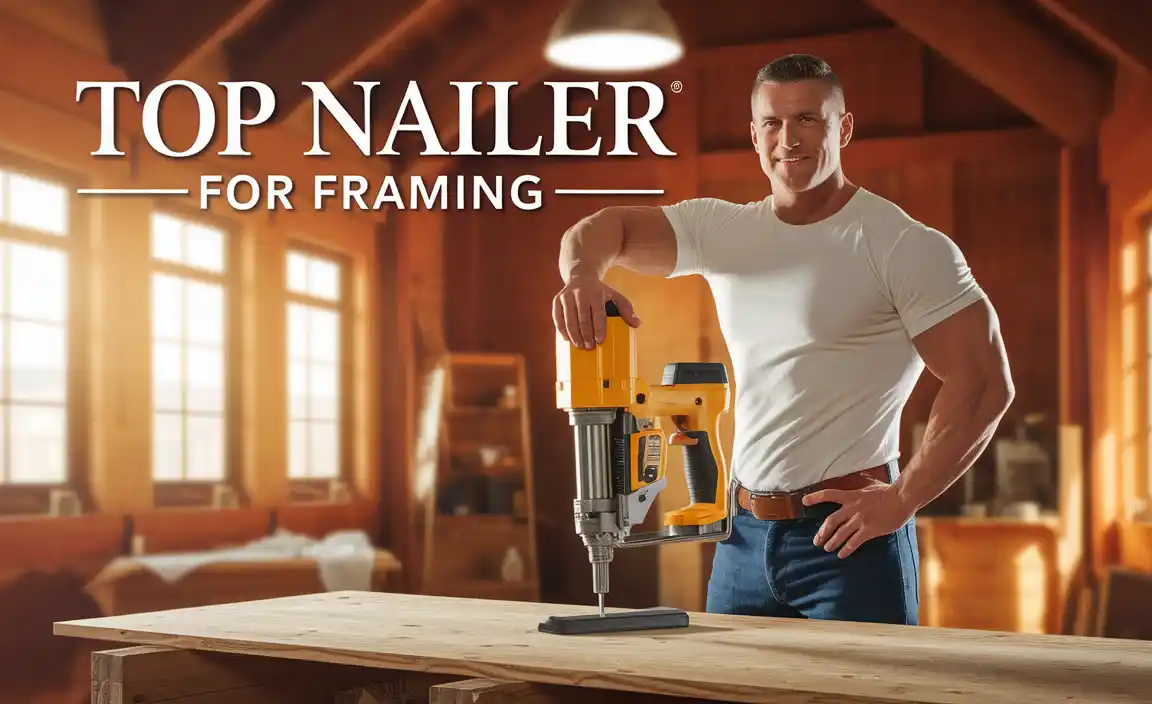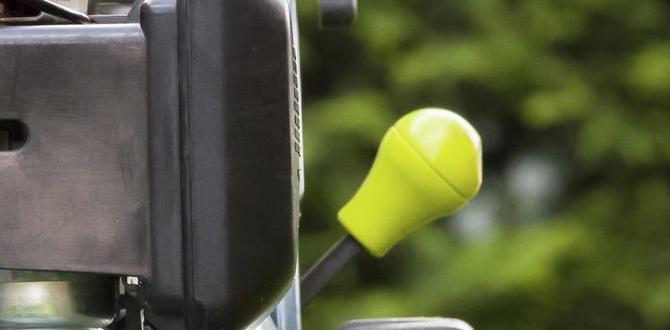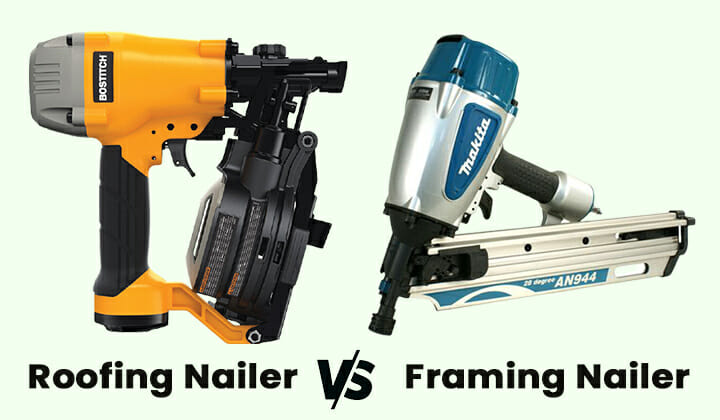Can you use a nail gun without an air compressor? Yes! Cordless and electric nail guns are readily available, offering a compressor-free solution for many DIY projects. These alternatives provide freedom from hoses and the compressor itself, making them convenient and versatile.
Hey folks, Jack Shaffer here from Nailerguy! Ever found yourself eyeing a DIY project, ready to bring all your creative ideas to life, only to see that bulky air compressor and tangled hose staring back? It’s a common sight for many DIYers. Using a nail gun often feels like it requires a whole setup, and honestly, that can be a bit intimidating when you’re just getting started or looking for a simpler way to get things done. The good news is, you don’t always need that classic compressor setup to drive nails effectively. There are fantastic alternatives out there that offer portability, ease of use, and all the power you need for many common tasks. Let’s dive into how you can power up your nailing projects without being tethered to an air compressor.
Table of Contents
Understanding Air Compressors and Nail Guns
Before we explore the compressor-free options, let’s quickly touch on why air compressors have been the traditional choice for powering nail guns. An air compressor is essentially a machine that compresses air and stores it in a tank. When you pull the trigger on an air-powered nail gun (often called a pneumatic nailer), a valve opens, releasing a burst of this compressed air. This powerful blast of air pushes a piston and a firing pin, which in turn drives a nail into your material.
This system is incredibly effective and has been a workhorse in construction and woodworking for decades. It offers high power, rapid firing, and a lightweight tool head because the heavy lifting (moving the air) is done by the compressor. However, it comes with some significant drawbacks:
- Portability: Compressors are heavy and bulky, making them difficult to move around a job site or even just a large workshop.
- Noise: They can be quite loud, especially when the motor kicks in to refill the tank.
- Ancillary Equipment: You need hoses, potentially air filters, and regular maintenance for the compressor itself.
- Power Source: Most require access to an electrical outlet, limiting where you can use them without extension cords.
These factors are exactly why so many people wonder, “Can you use a nail gun without an air compressor?” The answer is a resounding yes, thanks to some innovative tool technology!
The Compressor-Free Revolution: Alternatives to Pneumatic Nailers
The demand for more convenient and portable nailing solutions has led to the development of several excellent compressor-free nail gun technologies. These tools eliminate the need for an air compressor by integrating the power source directly into the nail gun itself. Let’s explore them:
1. Cordless Battery-Powered Nail Guns
These are the darlings of the DIY world right now, and for good reason! Cordless nail guns use a rechargeable battery pack (usually lithium-ion) to power a motor. This motor then drives the nail in one of two ways:
- Internal Combustion Engine (less common): Some older cordless models used a small internal combustion engine that ignited a fuel mixture to drive the nail. This is less common now due to safety and emissions.
- Motor and Spring/Ram Mechanism: The most common type features an electric motor that winds up a spring or compresses a ram. When you press the nail gun against the wood and pull the trigger, the motor releases this stored energy to drive the nail. Think of it as a powered hammer.
Pros of Cordless Nail Guns:
- Ultimate Freedom: No hoses, no compressor. You can take them anywhere!
- Easy Setup: Just charge the battery, load the nails, and go.
- Relatively Quiet: Much quieter than pneumatic nailers and compressors.
- Variable Power: Many models offer depth adjustment for precise nail setting.
- Versatile: Great for trim work, furniture building, fencing, and small framing jobs.
Cons of Cordless Nail Guns:
- Battery Life: You’re dependent on battery charge. Having a spare battery is often recommended for longer projects.
- Weight: They can be heavier than their pneumatic counterparts due to the battery and motor.
- Cost: The initial investment can be higher, especially if you need multiple batteries.
- Power Limitations: For very dense hardwoods or heavy-duty framing, some models might struggle compared to high-powered pneumatic nailers.
- Firing Speed: May not be as fast as high-end pneumatic nailers for rapid, continuous nailing.
2. Electric Nail Guns (Corded)
Electric nail guns offer a compressor-free solution by plugging directly into a wall outlet. They use an electric motor to power a mechanism that drives nails. These can be further broken down into a couple of types:
- Electric Staplers/Brad Nailers: These are very common and use a motor to drive a piston that fires nails or staples. They are relatively lightweight and easy to handle.
- Electric Ram-Type Nailers: Similar in principle to some cordless models, these use a powerful electric motor to drive a ram for firing nails.
Pros of Electric Nail Guns:
- No Batteries Needed: As long as you have power, you can keep working.
- Consistent Power: No worries about battery drain affecting performance.
- Lighter Tool Head: Often lighter than cordless models as they don’t carry a large battery pack.
- Lower Cost: Generally more affordable than cordless nail guns.
- Good for Stationary Work: Excellent for workshops or areas where you have easy access to power.
Cons of Electric Nail Guns:
- Tethered by a Cord: The power cord can be a nuisance, limiting mobility and posing a tripping hazard.
- Limited Reach: You’re restricted by the length of your extension cord.
- Less Portable: Not ideal for jobs that require moving around a lot or working in remote areas.
- Power Considerations: May not be as powerful as pneumatic or higher-end cordless models for demanding tasks.
- Potential for Electrical Issues: Cords can get damaged, and you need surge protection.
3. Fuel Cell (Gas-Powered) Nail Guns
Distinct from battery power, fuel cell nail guns use a combination of a small disposable fuel (propane or butane) cylinder and a rechargeable battery. When you pull the trigger, a small burst of fuel is injected into a combustion chamber and ignited by a spark from the battery. The resulting mini-explosion drives a piston, which fires the nail. The battery’s role is solely to provide the spark ignition.
Pros of Fuel Cell Nail Guns:
- High Power: These are often very powerful and can be excellent for framing and driving large nails.
- No Hoses or Compressors: Fully cordless and portable like battery models.
- Fast Firing: Can typically achieve very high nail firing rates.
- Good in Cold Weather: Less affected by cold temperatures than some battery-only tools.
Cons of Fuel Cell Nail Guns:
- Cost of Fuel Cells: You constantly need to purchase disposable fuel canisters, adding to the running cost.
- Fumes: They produce exhaust fumes, so good ventilation is essential. Not ideal for small, enclosed spaces.
- Operating Noise: Can be louder than battery-powered models due to the combustion.
- Maintenance: Requires cleaning of the combustion chamber periodically.
- Battery for Spark: Still requires a battery, though typically a smaller one than those used in pure battery-powered nailers.
- Smell: Some users report a distinct smell from the fuel combustion.
Choosing the Right Compressor-Free Nail Gun for Your Project
The best compressor-free nail gun for you will depend heavily on the types of projects you plan to tackle. Here’s a breakdown to help you decide:
Consider Your Projects
- Trim Work (baseboards, crown molding, window/door casing): A cordless or electric brad nailer or finish nailer is perfect. These take smaller, thinner nails (like 18-gauge brads or 16-gauge finish nails) that leave minimal holes, requiring less filling and sanding. Portability is a big plus here, making cordless ideal for renovations.
- Furniture Building: Similar to trim work, a cordless or electric finish nailer or brad nailer is excellent for assembling cabinets, picture frames, and other furniture components where clean aesthetics are important.
- Deck Repair or Small Deck Building: For driving thicker nails into structural wood, you might need more power. A cordless framing nailer or a powerful electric nailer could work. However, for extensive framing where speed and power are paramount, a pneumatic framing nailer might still be king, or a high-capacity cordless framing nailer designed for the job.
- Fencing or Shed Building: A cordless framing nailer is a great option, offering the power and portability needed to work outdoors away from power sources.
- Craft Projects & Upholstery: A lightweight electric or cordless brad nailer or even a powered staple gun is ideal for these smaller, detailed tasks.
Key Features to Look For
When comparing models, keep these features in mind:
- Nail Size and Type: Ensure the nailer accepts the size and type of nails your project requires. Nailers are typically categorized by the gauge of the nail they fire (e.g., 16-gauge, 18-gauge, 23-gauge) and the nail length.
- Depth Adjustment: This allows you to control how deep the nail sinks into the material. Crucial for preventing nails from protruding or being driven too deep.
- Firing Mode:
- Sequential Firing: You must press the safety contact tip against the wood before pulling the trigger to fire a nail. This is safer and more precise.
- Contact/Bump Firing: You can hold the trigger down and “bump” the safety tip against the wood to fire nails rapidly. Faster but requires more caution. Many modern nailers offer a switch to select between these modes.
- Ergonomics and Weight: If you’ll be holding the tool for extended periods or overhead, a lighter and well-balanced tool is essential.
- Battery System (for cordless): If you already own tools from a particular brand, check if you can use their existing battery platform. This can save you money. Look at battery capacity (Ah – amp-hours) for run time.
- Jam Clearance: How easy is it to clear a jammed nail? Tool-free jam release is a big convenience.
- Power: Ensure the tool has enough power for the density of the wood you’ll be working with.
Understanding Nail Types Used in Compressor-Free Nailers
The nails themselves are also important! Compressor-free nailers use collated nails held together by glue, paper, or plastic. The type of collation (how they are held together) and the angle of the magazine are important considerations for fitting into different spaces and for the nailer’s design.
Common Nail Gauges and Their Uses:
The gauge refers to the diameter of the nail shank. A lower gauge number means a thicker nail.
| Gauge | Nail Type | Typical Uses | Features |
|---|---|---|---|
| 23-Gauge | Pin Nails | Very fine detail work, trim where fasteners must be invisible, assembling delicate items. | Smallest head, almost invisible once driven. |
| 18-Gauge | Brad Nails | Trim work, molding, securing small pieces of wood, furniture assembly. | Very small head, leaves a small hole that’s easy to conceal. |
| 16-Gauge | Finish Nails | Door and window casing, baseboards, cabinetry, attaching molding. | Slightly larger head than brad nails, good holding power with a relatively unobtrusive hole. |
| 15-Gauge | Faux Finish Nails | Similar to 16-gauge finish nails but with a slightly larger head for more holding power, good for thicker trim. | Designed to look like traditional cut nails in some applications. |
| 14-Gauge | Detail/Casing Nails | Heavier trim, some furniture applications, where a stronger hold is needed than a 16-gauge. | A good balance between holding power and discreetness. |
| Up to 10-Gauge | Framing/Siding Nails | Structural framing, deck building, sheathing, fencing, subflooring. | Thickest nails with large heads for maximum holding power. These are typically used in more powerful pneumatic or specialized cordless framing nailers. |
Always check your nail gun’s specifications to confirm supported nail sizes and types. Using the wrong nails can cause jams, damage the tool, or result in improper fastening.
Safety First: Essential Precautions
Even without a compressor, a nail gun is a powerful tool that demands respect. Safety should always be your top priority. Here are some essential precautions:
- Read the Manual: Before using any new tool, familiarize yourself with its specific operating instructions and safety features.
- Wear Safety Glasses: Always wear ANSI Z87.1-rated safety glasses or a face shield to protect your eyes from flying debris or nails.
- Never Point at Anyone: Treat every nail gun as if it were loaded. Never point it at yourself or others, even if you think it’s disengaged or out of power.
- Use the Safety Contact Tip: Engage the “safety nose” or “contact trip” mechanism against the workpiece before you pull the trigger. This prevents accidental firing.
- Keep Fingers Away from the Trigger and Nose: Do not place your finger on the trigger unless you intend to fire a nail. Keep your hands and fingers away from the nail exit point.
- Turn Off When Not in Use: Disconnect the battery or unplug the tool when changing nails, clearing jams, or when the tool is not in use.
- Work in a Well-Ventilated Area: Especially important for fuel-cell models to avoid fume buildup.
- Secure Your Workpiece: Ensure the material you are nailing into is stable and won’t move unexpectedly.
- Double-Check Power Source: Ensure batteries are charged and firmly seated, or that cords are in good condition and properly connected.
For more detailed safety guidelines, the Occupational Safety and Health Administration (OSHA) provides comprehensive regulations for the safe use of power-driven fasteners and tools.
Maintenance for Compressor-Free Nail Guns
While these tools are designed for less hassle, a little basic maintenance will go a long way in ensuring they perform well and last longer.
- Keep it Clean: Wipe down your nail gun after each use to remove sawdust and debris. Pay attention to the nose and magazine.
- Lubrication (if applicable): Some models may require occasional lubrication at specific points. Consult your owner’s manual. Modern cordless and electric nailers often require very little or no user lubrication.
- Check for Jams: Clear any nail jams immediately. Don’t force nails into the magazine if they don’t feed smoothly.
- Battery Care: Follow the manufacturer’s instructions for charging and storing batteries. Avoid extreme temperatures.
- Inspect the Cord (for electric models): Regularly check the power cord for any cuts, fraying, or damage. Replace immediately if compromised.
- Fuel Cell Maintenance (for fuel models): Periodically clean the air filter and combustion chamber as per the manual’s instructions to ensure optimal performance.
When Might You Still Need a Compressor?
While compressor-free options are fantastic for DIYers and many professional applications, there are still scenarios where a traditional air compressor has an edge:
- Heavy-Duty Framing: For extensive framing projects on construction sites, the sheer power and continuous nailing speed of a high-CFM (Cubic Feet per Minute) pneumatic framing nailer, powered by a robust compressor, is often unmatched.
- Multiple Tools at Once: If you need to run more than one pneumatic tool simultaneously, you’ll need a compressor with sufficient air output.
- Budget




